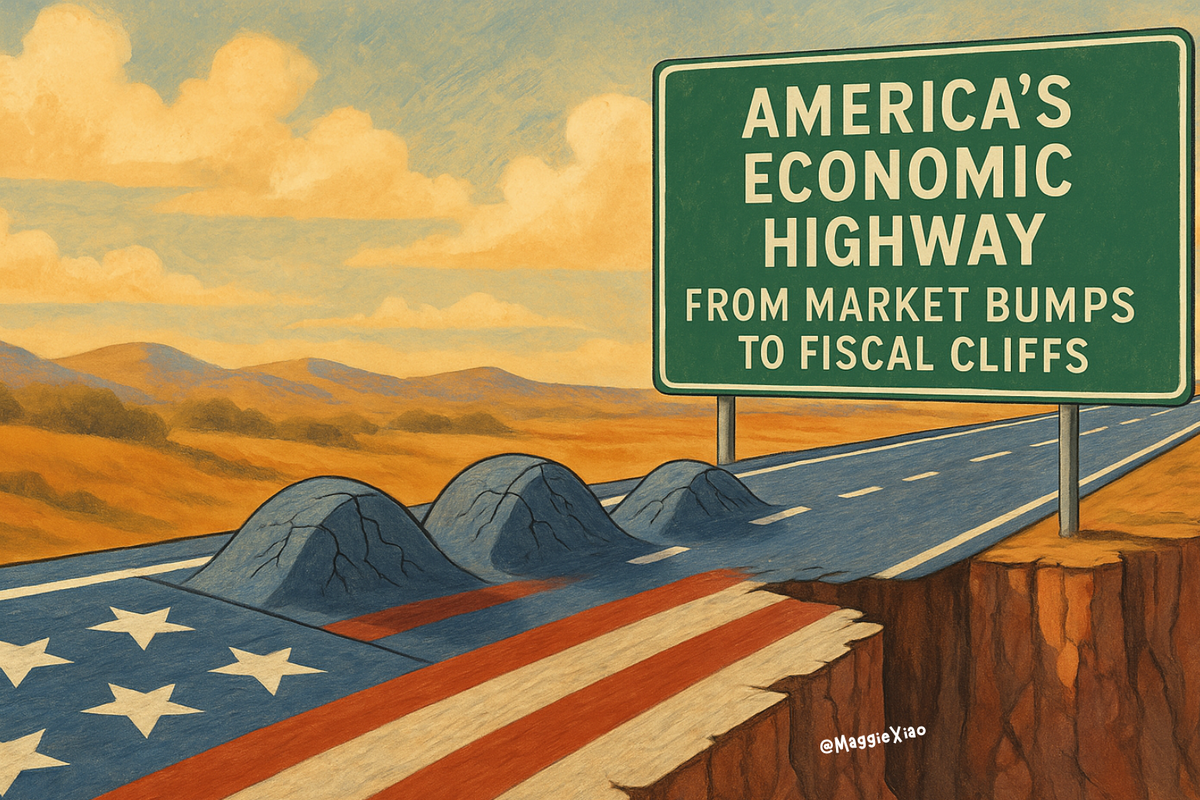Market risk, think the dot-com bubble in 2000 and the 2008 subprime mortgage securities excesses, has long been the go-to barometer for gauging the American economy’s health, from recession predictions to presidential approvals. Not anymore. A subtler, graver threat has taken over: fiscal risk, the barometer for gauging a government’s ability to balance its spending with the taxes it collects.
In October 2024, before the election results, Larry Fink, CEO and co-founder of BlackRock, reportedly claimed that
the outcome of the looming U.S. election between Kamala Harris and Donald Trump ‘really doesn’t matter’ for financial markets. —Larry Fink, October 2024
I shot back on X:
Because the stock “market makers” ( pun intended) have managed to shift the crisis to treasuries. Whoever wins is going to facing a mounting fiscal crisis.
— Maggie Xiao (@maggiexiao) October 22, 2024
My point? Market risk has become a distraction. America’s real economic threat isn’t Wall Street’s daily dance but the Treasury’s looming ledger.
The Safest Asset Turns Into the Riskiest One?
In mid-2022, amid the COVID-19 aftermath, J.P. Morgan published a conference transcript in which invited economists shared a striking statistic. The U.S. fiscal deficit had reached 3.7% of GDP in July 2022, and they estimated it would climb to over 7% by 2023, right at the peak of the economic cycle. (The transcript is no longer publicly available.)
In fact, according to the IMF, the U.S. national debt has ballooned to over $35 trillion by early 2025, with annual budget deficits consistently exceeding $1 trillion. This growing debt increases the U.S.’s reliance on foreign capital inflows to finance its escalating government spending, highlighting U.S. growing fiscal fragility.
Fast forward to 2024, Balaji Srinivasan, a venture capitalist and the former CTO of Coinbase, uncovered another bombshell of this fiscal crisis: a leaked letter addressed to the Federal Reserve, urging changes to accounting rules to mask the growing risks of U.S. treasury bonds!
I asked https://t.co/y4zMsdx9xx to do the reporting that legacy media won’t.
— Balaji (@balajis) March 6, 2024
In short, the safest asset in the world is now the riskiest asset in the world. If banks are forced to value US Treasuries correctly, they’re dead, so they are refusing to participate in Treasury… https://t.co/DnTX3utPOW
The letter, dated March 5, 2024, sent from the International Swaps and Derivatives Association (ISDA), requested that U.S. Treasuries be excluded from the Supplementary Leverage Ratio (SLR) calculations for banks, arguing that including them would discourage banks from participating in treasury markets, which could hurt the U.S. economy. In other words, if banks are forced to value U.S. treasuries correctly, they’re at risk of looking over-leveraged, so they are refusing to participate in treasury markets unless the accounting rules are relaxed. In short, U.S. treasury bonds, long seen as the “safest asset,” are now a liability banks are dodging, hinting at a fiscal reckoning markets haven’t priced in.
How Did America Get Here? Enter the Twin Deficits
Many might attribute disruptions like the COVID-19 stimulus, both monetary (printing money out of thin air) and fiscal (massive government spending), along with the Ukraine war and trade wars as the cause of America’s current fiscal crisis. But the problem has deeper roots. A concept called the Twin Deficits explains why this crisis has been a long time coming.
To understand the Twin Deficits, let’s start with the basics of how countries keep track of their money flows, a system called the Balance of Payments, or BOP. It’s like a big financial report with three main parts: the current account, the financial account, and the capital account. The capital account is a smaller player in this topic, covering things like debt forgiveness, so we’ll focus on the two key accounts: the current account and the financial account.
The current account tracks trade in goods, like Ford cars sold overseas, or services, like foreign users paying for Netflix, and income, such as money sent abroad to family or dividends earned from foreign companies. The financial account tracks investments, like when foreign countries buy U.S. government bonds, American company stocks, or even real estate in the U.S.
Historically, current account imbalances have driven growth in different ways. Taking U.S. as an example, during WWI, the U.S. ran a current account surplus as European gold flowed in to pay for American munitions, boosting the U.S. money supply and economy. Today's situation is the mirror image: the U.S. runs a current account deficit (importing more than we export) but maintains growth because this deficit is balanced by a financial account surplus: foreigners invest more in the U.S. than we invest abroad. This financial inflow has been key to offsetting the U.S. current account deficit, helping balance the overall balance of payments (BOP). It's like spending more than you earn while a friend keeps lending you money to cover the difference. Remember the word 'lending' here, because we'll come back to it later."
So, why have foreigners been so eager to invest, or, more accurately, to lend to the U.S. by buying its assets? It’s because of something called the fiscal balance: the overall picture of how much the U.S. government spends compared to how much it collects in taxes. For years, the U.S. has been able to borrow money by selling government bonds, which are seen as some of the safest investments in the world. Think of them as a super-secure savings account: countries like Japan and China buy these bonds knowing they’ll get their money back with interest, keeping the fiscal risk—the chance of the U.S. not paying its debts—almost nonexistent. This trust in U.S. assets has supported the U.S. financial account surplus, making it easy for the U.S. to balance its current account deficit without much worry.
For years, this setup worked fine globally. The U.S. could spend more than it earned because the dollar is the world’s go-to currency, and countries like China happily bought U.S. debt to keep their own currencies stable. This let the U.S. run deficits without worry, fueling global trade while foreign investment kept things steady. Everyone benefited: the U.S. got cheap goods, and the world got a safe place to park money.
But things have changed, and the risks are piling up. The U.S. government’s debt has skyrocketed to over $35 trillion by 2025, with yearly budget deficits, where the government spends more than it collects in taxes, topping $1 trillion. This is called the fiscal deficit, and it’s gotten worse with COVID-19 stimulus and ongoing spending to keep the economy afloat.
Here’s where things get interesting: such stimulus, both monetary and fiscal, along with supply chain disruptions, tariffs, and sanctions, caused inflation to soar. To combat that, the Federal Reserve had to raise interest rates. This higher interest rate environment made U.S. assets, like government bonds, more attractive to foreign investors, as they could earn better returns, encouraging foreign money to keep flowing into the U.S. despite the growing fiscal deficit. It looks gloomy on the surface, but this influx of foreign money only fueled the underlying fiscal deficit crisis. Why?
Remember earlier when we said the U.S. financial account surplus was like friends lending us money to cover our trade deficit, or the current account deficit? The word “lending” means foreign investors buying into U.S. government assets is considered a debt that the U.S. needs to repay. Therefore, the influx of hot money buying U.S. government bonds only fueled the U.S.’s existing fiscal deficit crisis. As a result, the Fed reported a net loss of $77.6 billion in 2024. This loss signals bigger financial strain, threatening the financial account’s ability to offset the current account deficit and making fiscal risk a much bigger worry than it used to be.
If such a fiscal deficit were just a one-time thing, caused by disruptions like COVID-19 and the Ukraine war, it wouldn’t be so alarming. However, the U.S. fiscal deficit problem began much earlier. In fact, the U.S. has long relied on its special role as the world’s reserve currency, letting it borrow more than other countries could. Economist Michael Pettis summarized this best in a 2023 post on X:
8/13
— Michael Pettis (@michaelxpettis) May 3, 2023
Because these foreign capital inflows don't fund increases in investment (which is constrained not by scarce capital but rather weak demand), instead they force down savings, either by raising unemployment or by raising household or fiscal debt.https://t.co/2oFZTEH90k
In other words, as Pettis points out, the dollar thrives not because it’s forced, but because no other economy dares run deficits big enough to balance global demand. This privilege, America as the world’s piggy bank, lets fiscal gaps widen unchecked. And the U.S.’s fiscal deficit crisis isn’t just a COVID hangover; it’s baked into the dollar’s dominance.
The Twin Deficits, the Triffin Dilemma and Trump’s Attempt at a Balancing Act
By now, the concept of the Twin Deficits should be clear: it’s when a country has both a current account deficit (imports exceed exports) and a fiscal deficit (government spending exceeds revenue). The Twin Deficits is still considered a hypothesis because the connection between the two deficits is still up for debate among macroeconomists.
But here’s the bigger problem: the U.S. can’t afford to have both the current account and the financial account in deficit at the same time. Remember, these are the two main pillars of a nation's Balance of Payments discussed earlier. For years, the U.S. had a financial account surplus, with foreigners investing in the U.S. more than the other way around, which offset the U.S. current account deficit, and this worked because of the world’s faith in the U.S. government’s fiscal balance, seen as rock-solid. But now, that balance is breaking down, with the U.S. government’s fiscal balance in crisis mode due to its massive debt and deficits. Think of the current account, financial account, and fiscal balance as a three-legged stool: when one leg weakens, like the fiscal balance, the whole structure starts to wobble.
This is how market risk, like stock market crashes, used to be the primary barometer to gauge the U.S. economy’s health, but now fiscal risk has taken the spotlight. So, when Larry Fink commented that the stock market’s performance is agnostic to whether Trump or Harris wins the election, he is not saying the market risks have been mitigated; what he means is that the market risk has shifted to fiscal risk, which is indifferent to the election result.
This isn’t a side issue Americans can shrug off. Trump’s recent treasury pick has mused about ditching market performance for a correction bear, grim, but not baseless. Markets may lag, but fiscal risk is rewriting America’s economic story. Ignoring it isn’t an option. Fixing it can actually bring back a healthier stock market and a stronger financial account.
That’s what I believe Trump’s economic advisory team is working to address: the U.S.’s growing fiscal risk head-on. For example, Stephen Miran, an adviser tapped by Trump in 2025 and the author of the Mar-a-Lago Accord, was asked in an interview about his take on the U.S.’s Twin Deficits challenge. Miran pointed to the dollar’s role as the world’s reserve currency, attributing the Twin Deficits largely to this dynamic, often called the Triffin Dilemma. Miran commented:
If you take the Triffin dynamics all the way to the limit, you get to a dilemma or a tipping point where bad stuff happens. We’re not there yet—it’s not plausible in my lifetime, certainly not in the near future in U.S. financial markets. —Stephen Miran, November 2024
While Miran’s optimism offers some comfort, the Twin Deficits remind us that America’s fiscal challenges are a long road ahead. Let’s hope the path forward brings more balance than tipping points.

